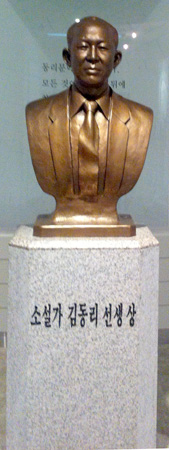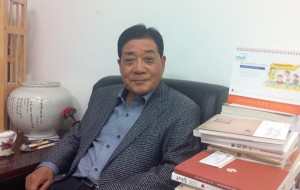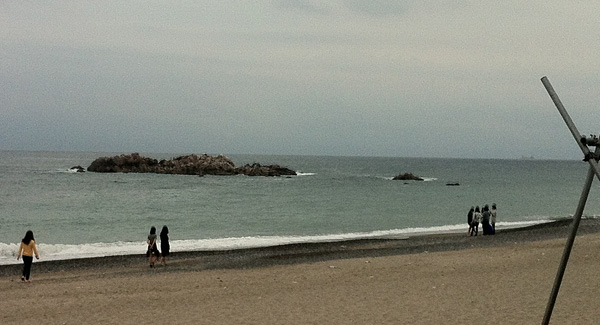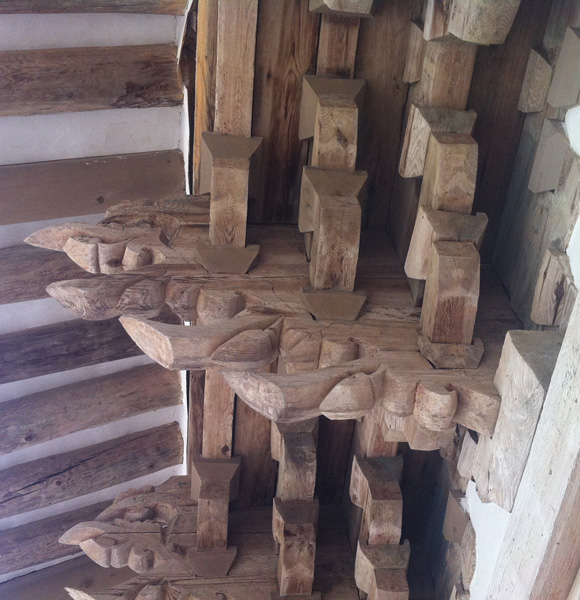
Kim Dong-ri
The second day was all about literature and literary sites. We awoke relatively late and headed off to breakfast at about 8:30. I had Galbi Tang, and pretty much everyone else had Sundubu Jiggae. Well fed, we headed to the Dong-ri Mog-wol Literary Museum (and school of creative writing). I had been here once before in 2009, an event which I talked about here.
However, at that time I was without any Korean (or Korean speakers) and had very little time, so despite how friendly the staff was, I rushed through it. This time would be different, as not only was I surrounded by Korean speakers, but we had plenty of time, and we were personally escorted by the Director, Mr. Jang, not only in the Museum, but to various literary sites in Gyeongju.
Mr. Jang gave us a tour of the Kim Dong-ri side first, after we poked around in it for a while. There was an amusing animation of Kim Dong-ri’s story “Loess Valley,” from a collection of the same name. In this story two rather stout Koreans have a kind of bromance/hate relationship, and they share fistfights, drinks, and occasionally girlfriends. The representation of the first femme fetale was hilarious, and you wouldn’t need to know the story to enjoy the animation.
Going slower was definitely the proper approach, as I noticed a lot of things I had missed the first go round. Kim’s wife was also a writer, and her collected works have been published in many volumes. Kim was also a calligrapher of some skill, and some examples of his art are shown in the museum, particularly in the corner in which his office is reproduced.
One of the interesting things about Kim Dong-ri is the abject poverty he suffered, in Gyeongju, in his youth – his mother was too old to breast-feed, his father impecunious, and Kim himself was so hungry as a child that he would wait until his father put down liquor cups and then quickly drink the dregs. As a result of his families’ financial condition, Kim was forced to drop out of school before university. I wondered where Kim had found the intellectual depth to become an author, and Mr. Jang explained that Kim’s older brother was a scholar of substantial knowledge, so much that at age 26 the older brother was teaching in Japan. Not just teaching,

Director Jang
but teaching about shamanism, with tied in quite well with why Kim himself was so interested in shamanism and restoring its spirit (Alive and well during the Silla period, shamanism was replaced, in order, by Buddha during the Koguryo renaissance and Confucianism during Joseon). Two of Kim’s most important stories are about the battle for shamanism’s survival, one being Shaman Sorceress (Sometimes “Ulwha the Shaman” in a collection of the same title) and the other being Tableau of a Shaman. The latter is the brutal story of a boy converted to Christianity returning home and engaging with his mother a shaman in a war for the soul of his sister. In fact, Kim’s stories in general focus on belief, even obsession, and when one combines that with the fact his stories are naturalistic and comprehensible, he’s a pretty good author to read for people without a lot of knowledge of Korean culture.
Before my stupid iPhone (“stupid iPhone!!”) misbehaved, I took two photos of a 4-scene diorama of Tableau of a Shaman, representing the boy returning home, and the war in the house between the religions.

Homecoming

A house divided against itself
Then, it was across to the Park Mog-wol half of the museum, about whom I know very little and of whose work only one volume exists in English (Selected Poems of Pak Mogwal). Park was also a kind of naturalist, and his relatively simple poetry lends itself well to translation, though obviously quite a bit is lost, as the following comparison reveals:
sanun
gugansan
borabit suksan
which loses a lot of its rythmn and consonant repetition when translated to:
The mountain is
Nine River Mountain
Purple stone mountain
Finally, Mr. Jang took us down into the collected libraries of Kim and Park: I should note that they were born within a few years of each other, and shared a long (despite both smoking; Kim lived to be 82) and happy friendship and thus it is that they share the museum. The library smelled awesome, in that way that only books can, and after Mr. Jang took us into his office for a cup of coffee. There he shared some events related to Kim that will be taking place in Seoul in the next few months, and I hope to report on some of them here.
Next, it was out into the field, where we were first taken to the Munmudaewang burial site. Munmdaewang was a king during the mid-silla period who, after a 20 year reign, asked that his body be buried off the coast of Silla, in the hopes that he would be reborn as a dragon who could defend Korea against invasion. The site is awesome, if a bit out of the way. The site relates to Kim’s works in that Kim, after a period of research on the area and its history, wrote a fictional account of the King’s tale, which has not yet been translated into English, so far as I can find. Still, it’s an awesome site/sight and we wracked our brains trying to think of other tombs like this? King Munmu is also responsible for the current location of Anapji pond which was originally located near Banwolseong.

Munmudaewang
Backtracking, we visited Geumansa, the temple slightly inland that was created to honor Munmudaewang, and allow rites to be performed in his honor, as this was impractical at his actual underwater burial site.^^ It is a bit wrecked (about to undergo possible reconstruction), but sited in a beautiful valley and as you look back out between the hills you can see a flash of the sea, and imagine what it might have looked like before trees and modern buildings blocked the view.
Then it was a trip to another site tied to Kim Dong-ri’s work, Girimsa (Girim Temple), which is mentioned early in Shaman Sorceress (Ulhwha the Shaman) as the most beautiful temple in the area. While Girimsa has stiff beauty competition in Bulguksa, a far better known and much more centrally located temple, it does have its own different kind of beauty, being farther (much farther) from the city, and featuring a kind of unvarnished wood-style (see photo) that is much more natural than the highly artificial painting found on most temples in Korea. Not to say that there aren’t plenty of painted buildings in Girimsa, but there are also many of the more ‘harmoniously’ styled buildings as well.

Unpainted detail
During all this, at lunch, one of our awesome Arirang crew took it on themselves to help Sanjay read some of “Tableau of a Sorceress.” I can’t stress enough how great this crew has been.

Every day’s a school day!


